Notes For All Chapters Biology Class 11 CBSE
Cells continuously use oxygen (O2) for the catabolic reactions that releases energy from molecules, e.g., breakdown of nutrient molecules like glucose. Thus, O2 has to be provided to the cells constantly. Simultaneously, these reactions releases carbon dioxide (CO2), which is harmful, so it must be removed quickly and efficiently.
The process that helps in the exchange of O2 from the atmosphere with CO2 produced by the cells is called breathing, commonly known as respiration.
Topic 1 Respiration : Types and Respiratory Organs
Respiration is a biochemical process that exchanges environmental oxygen with the CO2 produced in the cells. It include stepwise oxidation of food in cells with intake of oxygen and elimination of CO2 produced in oxidation, release of energy during oxidation and storing it in form of ATP.
Types of Respiration
Mechanism of respiration vary, depending mainly on an animal’s habitat and levels of organisation.
The different types of respiration are
1. Aerobic Respiration
When oxygen is used for respiration, its called aerobic respiration. The organism undergoing the process are termed as aerobes.
The term breathing and respiration are not same. Breathing is the first step of respiration and a physical process, while respiration is a biochemical process involving exchange of gases and oxidation of food.
Inspiration is an active process, while expiration is a passive process.
2. Anaerobic Respiration
It occurs in the absence of molecular oxygen in the cytoplasm (also called as fermentation). It yields only about 5% of the food’s energy. The organisms undergoing the process are called anaerobes, e.g., yeasts oxidise glucose to ethanol and CO2.
* Anaerobic respiration appeared first in primitive atmosphere due to absence of oxygen there.
* In frog 100% cutaneous respiration occurs during hibernation and in all marine snakes, 20% respiration is by skin.
* Respiration is a catabolic process. It breaks organic molecules and release their bond energy. It occurs in all organisms, at all times.
Respiratory Organs
Different animal groups have evolved different mechanism of breathing for the exchange of gases.
Lower animal like sponges, cnidarians, Platyhelminthes and free-living roundworms exhange 02 by simple diffusion through body surface.
Special vascularised structures called gills are used by most of the aquatic arthropods and molluscs whereas, vascularised bags called lungs are used by the terrestrial forms for the exchange of gases.
Parasitic flatworms (e.g.. Tapeworms) and roundworms (e.g., Ascaris) have anaerobic mode of respiration.
Human Respiratory System
Human respiratory system may be divided into two major components, i. e., conducting portion and respiratory or exchanging portion.
Conducting Portion
It is the passage for the air (transports the atmospheric air to alveoli and return from lungs to the exterior). This portion clear air from foreign particles, humidifies it and also brings it to body temperature. In this part, gaseous exchange does not take place. It is also called dead air space. It starts with the external nostrils upto the terminal bronchioles.
The various parts are as follows
(i) External Nares (Nostrils) These are a pair of slits at the lower end of the nose, which opens into the the nasal chamber through the nasal passage.
(ii) Nasal Chambers Pair of passage located at the back of nostrils just above the mouth cavity. Nasal septum is a median partition that separates the two chambers.
Each chamber has three regions, i.e., Vestibular, respiratory and olfactory. The chambers has special pseudostratified ciliated epithelium by which air is filtered (by hairs) and moistened (by mucus).
(iii) Internal Nares These are the posterior openings of the nasal chambers that leads into the nasopharynx.
(iv) Nasopharynx It is the upper part of pharynx, into which internal nares open.
(v) Larynx It is the upper part of trachea. It allows the air to pass into lungs. Nasopharynx opens through glottis of the larynx into trachea. Glottis is a slit-like aperture that remains open except during swallowing.
The glottis bears a leaf-like cartilaginous flap, the epiglottis at its anterior region. It closes the glottis to check the entry of food during swallowing. Larynx helps in sound production and hence, called the sound box.
Larynx is often called the Adam’s apple and is more prominent in men than in women.
(vi) Trachea It is a thin-walled tube, about 11cm long and 2.5 cm wide. It extends up to the mid-thoracic cavity. It passes the air to the alveoli.
(vii) Primary and Secondary Bronchi At the level of 5th thoracic vertebra, the trachea divides into two tubes, right and left primary bronchi.
Each bronchi further divides into lobar or secondary bronchi. The secondary bronchi sub-divides into smaller tertiary bronchi, which divide into still smaller bronchioles. The small terminal bronchioles give off a number of thin, irregular walled, vascular bag-like structure called alveoli.
Note:
* Wall of trachea, bronchi and bronchioles is composed of fibromuscular tissue and is lined by pseudostratified ciliated columnar epithelium rich in mucus secreting cells.
* Cartilaginous rings support the walls of the trachea and the bronchi to prevent their collapsing.
Respiratory/Exchanging Portion
The alveoli and their ducts form this part of the respiratory system. It is the site of actual diffusion of O2 and CO2 between blood and atmospheric air. The branching network of bronchi, bronchioles and alveoli comprises the lungs, which provide the surface for exchange of gases in humans.
Lungs
These are the paired triangular bags that constitute the respiratory organ.
They lie in the thoracic cavity on the sides of the heart. The thoracic cavity is enclosed dorsally by thoracic vertebrae, laterally by the ribs, ventrally by the sternum and closed below by a dome-shaped diaphragm.
The arrangement of lungs is such that, any change in the volume of thoracic cavity will be manifested in the lung (pulmonary) cavity. This arrangement is necessary for breathing as the pulmonary volume cannot be altered directly.
Protective Coats (Pleurae)
Each lung is enclosed in two membranes called the pleura (layers of peritoneum of the thorax). The inner membrane, called the visceral pleuron, which is firmly bound to the surface of lungs. The outer membrane, called the parietal pleuron is held to the thoracic wall and diaphragm by connective tissue. Pleural cavity is a very narrow space that exists between the two pleura. It contains the pleural fluid secreted by the pleura, for reducing friction on the lung surface.
External Features
(a) The left lung has two lobes, i.e., superior lobe and inferior lobe separated by oblique fissure. It has a cardiac notch, a concavity where the heart lies. It is longer and narrower than right lung.
{b) The right lung is bigger and has three lobes, i.e., superior lobe, middle lobe and inferior lobe separated by horizontal fissure and oblique fissure.
Note:
* There are about 300 million alveoli in the two lungs with a combined surface area of about 70 m2.
* A film of lecithin lines the alveoli, that lowers the surface tension.
* Larynx is comprised of 9 cartilages (epiglottis, thyroid and cricoid are single, while arytenoid, comiculate and cuneiform are paired).
* If the chest wall is pierced (e.g., by a stab wound), atmospheric air rushes into the pleural cavity, eliminating the pressure difference across lung walls causing the lungs to collapse. The condition is called pneumothorax.
Topic 2 Respiration Processes : Breathing and Gaseous Exchange
The main mechanisms of respiration is categorised into following three steps
(i) Breathing (pulmonary ventilation) is the inflow of atmospheric air and release (outflow) of CO2 rich alveolar air.
(ii) Exchange of gases (O2 and CO2) across alveolar membrane as well as in tissues.
(iii) Transport of gases by the blood.
Breathing
Breathing is an extracellular, energy consuming and physical process. It involves movement of thorax, expansion (inflation) and deflation of lungs and flow of air into and from the lungs by creating a pressure gradient between the lungs and the atmosphere.
The diaphragm and a specialised set of muscles, i.e., external and internal intercostals between the ribs help in generation of such gradients.
Breathing mainly involves two steps
i. Inspiration
It is an active process by which fresh air enters the lungs. It can occur if the pressure within the lungs (intra-pulmonary pressure) is less than the atmospheric pressure, i.e., negative pressure in lungs with respect to atmospheric pressure.
Following muscles play an important role
(a) Diaphragm It is lowered by the contraction of its muscle fibres and becomes flat. This causes an increase in the volume of thoracic chamber in the antero-posterior axis.
(b) External intercostal muscles They occur between the ribs (internal intercostal muscles are related to expiration). The external intercostal muscles contract and pull the ribs and the sternum upward and outward thus, increasing the volume of thoracic chamber in dorso-ventral axis.
Accessory muscles of breathing, i.e. scaleni, sternomastoid and ala nasi come into action during forced inspiration.
Thus, the overall increase in the volume of thoracic cavity causes an increase in pulmonary volume. As a result, there is a decrease in the intra-pulmonary pressure. The , greater atmospheric pressure outside the body now causes air to flow rapidly into external nares, which sequentially leads to alveoli.
ii. Expiration
It is a passive process by which CO2 is expelled out from the lungs. It takes place when the intra-pulmonary pressure is higher than the atmospheric pressure.
The movement of muscles involved is as follows
(a) Diaphragm The muscle fibres of the diaphragm relax making it convex, decreasing volume of the thoracic cavity.
(b) Internal intercostal muscles These muscles contract thus, pulling the ribs downward and inward, decreasing the thoracic volume.
Abdominal muscles (i.e., external and internal oblique muscles) contracts, compressing the’ abdomen and pushing the diaphragm up.
The overall volume of the thoracic cavity thus, decreases thereby reducing the pulmonary volume.
As a result, the intra pulmonary pressure increases slightly above the atmospheric pressure. This inturn causes the expulsion of the air from the lungs. The process of expiration is simpler than inspiration.
Note:
* At rest, breathing occurs about 12-16 times/minute, being more in children.
* The volume of air involved in breathing movements can be estimated by using a spirometer. It helps in clinical assessment of pulmonary functions.
* Breathing in frog is considered as positive pressure.
Respiratory Volumes and Capacities
The quantity of air the lungs can receive, hold or expel under different conditions are called respiratory (or pulmonary) volumes.
Combination of two or more pulmonary volumes are called respiratory (pulmonary) capacities.
The different volumes and capacities are as follows
(i) Tidal Volume (TV) It Ms the volume of air inspired or expired during normal breathing in relaxed or resting position. It is about 500 mL. It consists of 150 mL of dead space volume and 350 mL of alveolar volume.
A healthy man can inspire or expire approximately 6000-8000 mL of air per minute.
(vi) Expiratory Capacity (EC) It is the total volume of air a person can expire after a normal inspiration. It includes tidal volume and expiratory reserve volume.
EC= TV+ ERV
(vii) Functional Residual Capacity (FRC) It is the volume of air that will remain in the lungs after a normal expiration. It includes residual volume and expiratory reserve volume.
FRC= RV+ ERV
(viii) Vital Capacity (VC) It is the maximum value of air a person can breathe in after a forced expiration or the maximum volume of air a person can breathe out after a forced inspiration. This includes TV+ IRV+ ERV.
It varies from 3400-4800 mL depending upon age, sex and height of individual.
(ix) Total Lung Capacity It is the total volume of air present in the lungs after a forced (maximum) inspiration. It includes (VC+RV) or (RV+ ERV+ TV+ IRV)
Note:
* The vital capacity is higher in athletes, mountain dwellers than in plain dwellers, in men than women and in the young ones than in the old persons.
* All pulmonary volumes and capacities are about 20-25% less in women than in men and they are greater in tall persons and atheletes than in small and asthenic people.
* During respiration, the lungs and the respiratory tract are never devoid of air. Instead, there is a tidal volume of air.
Exchange of Gases
The primary sites for exchange of gases are the alveoli and tissues.
It occurs by simple diffusion mainly based on pressure/ concentration gradient.
The factors that affect rate of diffusion are
(i) Thinness of the membrane.
(ii) Surface area of the membrane.
(iii) Permeability of the membrane.
(iv) Solubility of the gases.
(v) Partial pressure gradient (difference) of gases on the two sides of a membrane between them.
Partial pressure of a gas is the pressure it exerts in a mixture of gases. It is equal to the total pressure of the mixture divided by percentage of that gas in the , mixture.
1. Inspiratory Reserve Volume (IRV) It is the additional amount of air that can be inspired forcibly after a normal inspiration. It is about 2500-3000 mL of air.
2. Expiratory Reserve Volume (ERV) It is the additional volume of air that can be expired forcibly after a normal expiration. It is about 1000-1100 mL.
3. Residual Volume (RV) It is the volume of air remaining in the lungs even after a forcible expiration. It is about 1100-1200 mL. It can not be measured by spirometry.
4. Inspiratory Capacity (IC) It is the total volume of air a person can inspire after a normal expiration. It is about 2500-3000 mL. It includes tidal volume and inspiratory reserve volume.
IC= TV+ IRV
Partial Pressure (in mm Hg) of Oxygen and Carbon dioxide at different parts Involved in Diffusion in Comparison to those in Atmosphere
i. Exchange of Gases between Alveoli and Blood
This exchange between lung alveoli and pulmonary capillaries is called external respiration.
The alveolar wall is very thin with a rich network of blood capillaries. It is also called as respiratory membrane or diffusion membrane.
It consists of three major layers, i.e., the thin squamous epithelium of alveoli, the endothelium of alveolar capillaries and the basement substance in between them. All these layers form a membrane of about 0.2 mm thickness.
This membrane has a limit of gaseous exchange between alveoli and pulmonary blood, called the diffusing capacity.
At a particular pressure difference, the diffusion of CO2 is 20-25 times faster than oxygen. Thus, the amount of CO2 that can diffuse through the membrane per unit difference in partial pressure is much higher as corrtpared to oxygen.
As seen in the above table, pO2 in the alveoli (104 mmHg) is higher than that in the deoxygenated blood in the capillaries of pulmonary arteries (95 mmHg). So, the movement of O2 is from alveoli to the blood.
Also, pCO2 is higher in deoxygenated blood (45 mmHg) than in alveoli, therefore, CO2 passes from blood to the alveoli.
ii. Exchange of Gases between Blood and Tissue Cells
This exchange between tissue blood capillaries and tissue cells is called internal respiration. pO2 in oxygenated blood (95 mmHg) > pO2 in body cells (40 mmHg) and pCO2 in oxygenated blood (40 mmHg) < pCO2 in body cells (45 mmHg).
Due to this partial pressure differences, oxygen diffuses from the capillary blood to the body cells and CO2 diffuses from the body cells to the capillary blood via tissue fluid. Now, the blood will become deoxygenated, which is further carried to the heart and finally to the lungs.
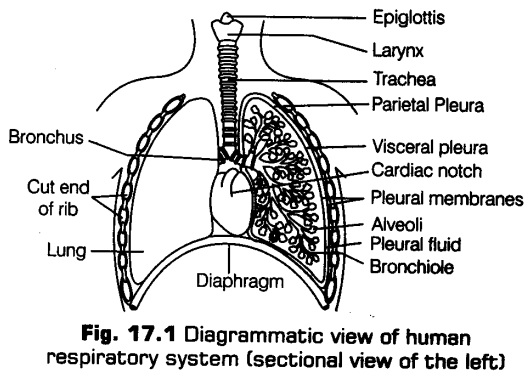
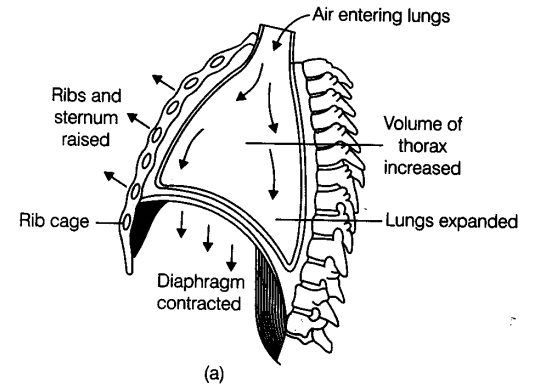
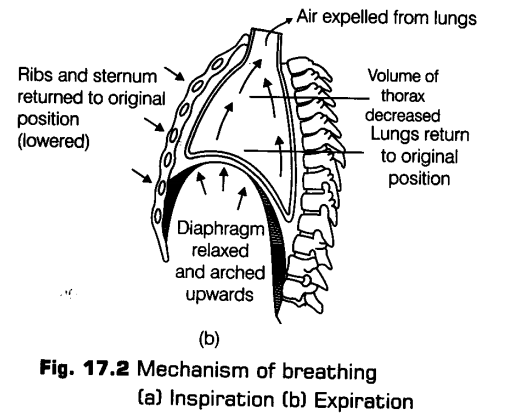

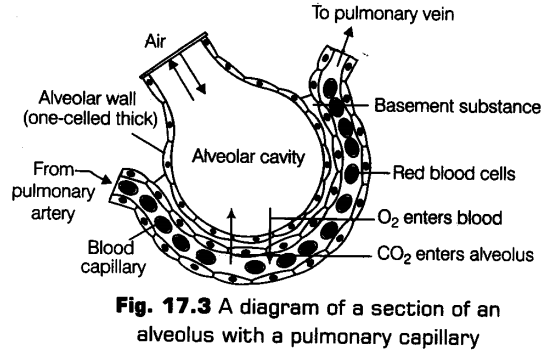
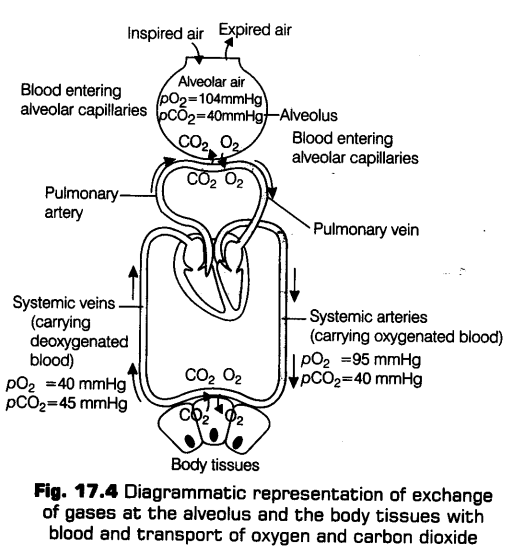

Leave a Reply